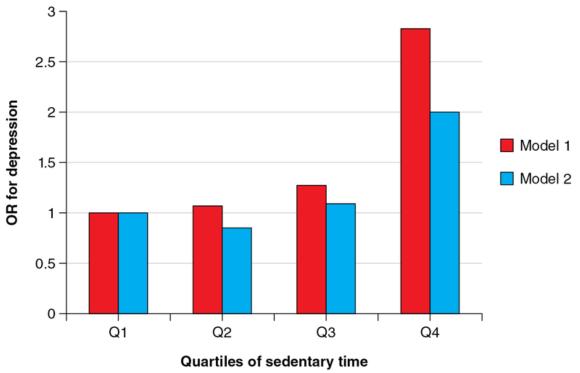Sedentary Behavior and Depression
This is an excerpt from Sedentary Behavior and Health by Weimo Zhu,Neville Owen.
Teychenne, Ball, and Salmon (2008) conducted a systematic review on depression and sedentary behavior in adults. Seven observational (5 cross-sectional and 2 longitudinal) and four intervention studies were included. Of the observational studies, 6 of 7 showed a positive association between sedentary behavior and depression; that is, higher sedentary behavior was associated with greater depression. The other study also showed this for time spent surfing the Internet, but reported negative associations for depression with hours spent e-mailing and using chat rooms. This suggests that the type of sedentary behavior may be an important moderator of any association between sedentary behavior and depression. More is said on this subject later in the chapter.
The four intervention studies reviewed by Teychenne et al. (2008) showed mixed results: one study showed no effect and one showed an increase in depression after the introduction of free computer and Internet use, while two showed that the risk of depression was reduced during the intervention. One provided extra computer and Internet use while the other used extra chat sessions. The latter may have boosted well-being through social interaction. It is important to note that the authors of the review concluded that at the time, no interventions had attempted to reduce sedentary behavior in an effort to assess changes in depression.
Since the review by Teychenne et al. (2008), there have been several large-scale epidemiological studies published on this topic. Vallance and colleagues (2011) analyzed data from 2,862 adults from the National Health and Nutrition Examination Survey (NHANES) for 2005-2006. This is a national survey of U.S. adults that, for this time period, assessed physical activity and sedentary behavior objectively using accelerometers. Depression was assessed using the Patient Health Questionnaire-9.
Results showed that in comparison to the least sedentary quartile (the reference group), there was a trend for a greater risk of depression for those with higher levels of sedentary behavior. This was most clearly shown in the most sedentary quartile. This is shown in figure 12.1 for data from model 1 (odds ratios adjusted for gender, ethnicity, and age) and for model 2 with additional adjustment for other sociodemographic factors, health status, and moderate- to vigorous-intensity physical activity (MVPA). Although model 2 shows some attenuation of the odds for depression, the same trend is evident, and the most sedentary group has a twofold elevated risk of depression over those in the lowest sedentary quartile.

Odds ratios (OR) for depression across quartiles of objectively assessed sedentary time from the NHANES study. Model 1 is the least adjusted model and model 2 is the most adjusted.
Data from Vallance et al. 2011.
Learn more about Sedentary Behavior and Health.
More Excerpts From Sedentary Behavior and HealthSHOP

Get the latest insights with regular newsletters, plus periodic product information and special insider offers.
JOIN NOW


